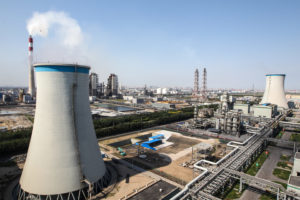In a sobering report released by the Global Carbon Project during the annual UN climate summit being held in Poland, Chinese and Indian emissions were identified as the key drivers in global emissions. After a brief lull in growth, fossil carbon dioxide emissions that cause global warming are likely to rise by as much as 2.7% in 2018 after expanding by 1.6% last year. The projected rise is driven by “solid growth” in coal use for the second year in a row, and “sustained growth” in oil and gas use.
This development comes after three years of little or no growth and is reminiscent of the decade ending 2013 (known as the year of peak coal), when emissions grew by over 3% every year. That peak could be surpassed if coal use continues to rise in China and India.
This also contrasts strongly with the aspirations of the two countries to be seen as climate leaders, a role that the global community has been urging them towards, especially as the US has moved away from that position under the leadership of Donald Trump.
The spurt could compromise the aims of the Paris climate pact to keep temperatures “well within” 2 degrees Celsius, even as the annual UN climate summit meets in the col mining city of Katowice in Poland to devise a rulebook or guidelines to implement the Paris Agreement.
The additional emissions will add 2.3 ppm of carbon dioxide to the atmosphere to reach 407 ppm by the end of 2018, which is 45% above pre-industrial levels.
IPCC report
The Intergovernmental Panel on Climate Change has recently warned in a special report that to limit global warming to 1.5 degrees, “rapid, far reaching and unprecedented changes in all aspects of society” is required. The world has only dozen years to stay within 1.5 degrees, climate scientists have said, and just half a degree more will significantly worsen risks of extreme heat, storms, floods and droughts for millions of people.
See: 1.5 degree ambition demands radical change, UN warns
The IPCC has said that to limit warming well below 2 degrees Celsius, carbon emissions have to decline by about 20% by 2030, and reach “net zero” around 2075; to keep warming below 1.5 degrees, CO2 emissions should decline by 50% by 2030 and reach net zero around 2050. Current commitments by national government will lead to more than 3 degrees of warming by the end of the century, which will have catastrophic effects, the IPCC says.
“Emissions need to peak and rapidly decrease to address climate change,” said Corinne Le Quéré, lead researcher of the Global Carbon Budget 2018. “With this year’s growth in emissions, it looks like the peak is not yet in sight.”
Oil use is growing strongly in most regions including the US and Europe, driven up by the rise in emissions from transport, the report said. The growth in renewables is yet to offset expansion in fossil energy and besides energy, decarbonisation has to happen with transport, buildings and industry as well, it said. “The goal of reaching a decarbonised economy by 2050 seems far-fetched today
“The growing global demand for energy is outpacing decarbonisation for now. This needs to change, and change quickly to address climate change,” said Le Quéré, who teaches climate change science and policy at the University of East Anglia in the UK. “We need strong policy and economic support for rapid deployment of low carbon technologies to cut emissions across the energy and transport sectors, from buildings and from industry.”
The rise in CO2 emissions in 2018 is being also driven by increased coal use in China and India, the report revealed. Global coal use is still 3% lower than its historical high in 2013, but if the return to growth in the past two years keeps up, the 2013 peak will soon be passed.
China’s emissions, accounting for 27% of global emissions, look set to grow about 4.7% in 2018, reaching a new all-time high. Emissions from coal use are projected to grow about 4.5% to almost surpass coal’s 2013 peak in the country.
India’s emissions account for 7% of global emissions, and will grow strongly by about 6.3% in 2018, with use increasing with all fossil fuels. While it is aggressively adding solar and wind power capacity, coal consumption continues to climb. However, coal-fired power stations have been operating well short of capacity and further addition has stalled.
Read: China air pollution moves confront unintended consequences
![<p>Among the painful changes India may have to make is to shut coal plants before the end of their economic lives [image by: Vikramdeep Sidhu / Flickr]</p>](https://dialogue.earth/content/uploads/2018/12/india-coal-plant.jpg)








